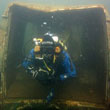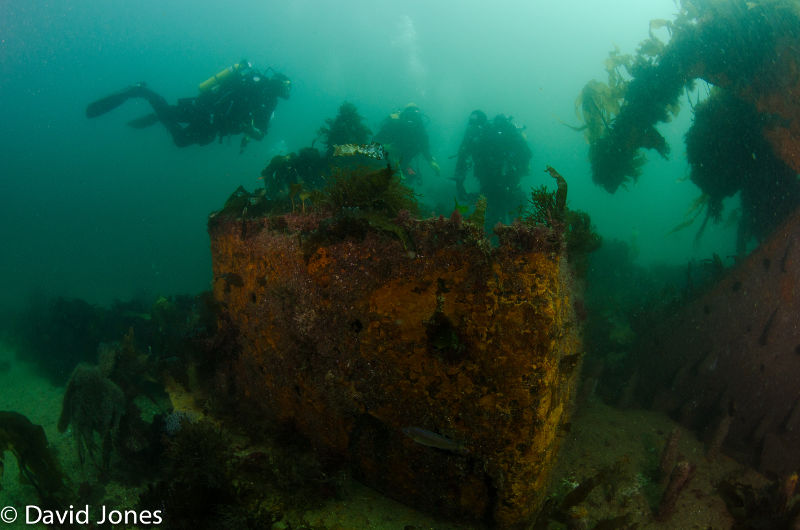Thank you for all your support for our charity dive!
Another success for MAST! We have just completed our 2.9 km charity relay scuba dive.
We are happy to report that the MAST/Battle Back team have successfully completed their 2.9 km charity relay dive. Rather than the standard baton handed over in "normal" relays, divers preparing to surface after their dive passed on a line attached to a floating buoy to the new divers who had just reached the seabed. Each diving pair were given a bearing before they jumped in which took account for any tidal current pushing us a bit to the east. And yes we found all three wrecks sites.


Thanks to Fintan and
Who
Our team were taken to the site on Fintan, skippered by Chris Howe who generously offered his services for free. The divers consisted of a crew of commercial and scientific divers and a contingent of serving and ex military divers. Battle Back, set up in 2008, was launched to help seriously wounded military personnel from the army, navy and airforce regain independence and confidence by participating in sport and adventurous training normally only available to the able bodied so that they can focus on what they can achieve, rather than what they can't.
Click below photos to see some of our divers
 Rob Jackson EngTech MIMechE
Rob Jackson EngTech MIMechE
Rob Jackson EngTech MIMechE
Rob is a Battle Back diver. He served in the RAF for 15 years as an armourer dealing with explosives. He completed several operational tours in Iraq and Afghanistan.
He walks with a limp now, which is not surprising given his injuries:
"Right tib and fib shattered, they did two twists round my leg. Right femur open fracture, bone came out front of my leg. Compartment syndrome to right leg leading to fasciotomies. Lost four cm of bone in right leg. Right ankle now fused as never able to heal properly. Left knee all ligaments ripped out bone. Left nerve to foot damaged. Open fracture of the right middle finger. Grade three separation of right shoulder"
"In hospital they told me I wouldn't keep my legs. Then they said I wouldn't walk. When I did, they said I wouldn't run. I just wanted to prove them all wrong."
"Battleback has given me the confidence to meet new challenges: things that I didn't think were possible now are. It gives a sense of achievement when you overcome the obstacles resulting in pride in how far I have come." Mark Pearce
Mark Pearce
Mark Pearce
Visits licensee for the Coronation Wreck Project, a keen amateur underwater archaeologist and researcher. He has dived in many parts of the world and is an occasional writer for dive magazines. Ginge Crook
Ginge Crook
Ginge Crook
Ginge is Dive Supervisor at Plymouth Universit. He is the licensee of the 17th century Coronation wreck site in Cornwall, BSAC National Instructor, PADI Instructor, HSE SCUBA diver, rebreather and trimix diver. He lives and works in the south west England as a professional maritime instructor and part-time member of the DDRC Hyperbaric medical centre staff. He has been diving since 1984. Tom Cousins
Tom Cousins
Tom Cousins
Tom is a marine archaeological technician and diver who has worked on various marine archaeological projects in the UK including protected wrecks such as the West Bay Wreck and Swash Channel Wreck in Dorset and the Salcombe Cannon site in Devon. He’s an HSE Part IV diver. Kevin Stratford
Kevin Stratford
Kevin Stratford
Kevin is a maritime archaeologist. He has also been involved with archaeological work on a wide range of sites including the 17th century Swash Channel Wreck in Poole, Dorset since shortly after its discovery in 2004. He is an HSE Part III and a CMS 3* diver and a PADI Open Water Instructor. Jean-Marc Jefferson
Jean-Marc Jefferson
Jean-Marc Jefferson
Jean- Marc has been diving since 1985. More recently, he re-qualified to Master Scuba Diver with PADI and to Advanced (Hypoxic) Trimix with BSAC. His favourite dives are the Coronation, the Polynesien (off Grand Harbour, Malta) and of course, the James Egan Layne (off Whitsand Bay). Strangest experience: Clearing out Kew Gardens pond as part of a London School of Diving team which found 2 shotguns. Jessica Berry
Jessica Berry
Jessica Berry
Jessica has been diving since 1987. She’s an HSE Part IV and Part III diver, a PADI Divemaster and a BSAC Advanced Diver. She’d be quite happy living underwater. Charlie Sandercock
Charlie Sandercock
Charlie Sandercock
Charlie has been diving since 1990, taking in the sites all over the world from Mozambique to Russia. He is currently working as an HSE Professional SCUBA (Part IV) Instructor with Plymouth University as well as the odd commercial contract with various companies around the UK. He has dived in and around Plymouth for the last 15 years and is still finding new aspects to it. Rebecca Harris
Rebecca Harris
Rebecca Harris
Bex is a diving instructor at Plymouth University and has been diving since 2000. She is BSAC Instructor, PADI Staff Instructor and HSE Scuba Diver. She enjoys all aspects of the underwater world whether it's in warm tropical waters or under the ice in Russia. David Jones
David Jones
David Jones
David Jones served for 17 years in the Royal Engineers before retiring to concentrate on business interests. During his service he was attached to various units including 33 EOD, The Queen's Gurkha Engineers and the Defence Diving School. He started diving in 1978 (obviously he would have been aged 3 at the time) and has been diving ever since clocking up thousands of dives over the years. He is now a BSAC Advanced Instructor, PADI Course Director and IANTD CCR Trimix Instructor and is the owner of Triton Scuba based in Portsmouth.
Some of the team at the last point on the relay

Where
Three wreck sites just south of the Plymouth Breakwater.
Battle Back represents all three services - army, Royal Navy and RAF. Our three wreck sites do the same (Land Sea and Air). One wreck, the Poulmic, was a French troop carrier until she was requisitioned in 1940, there's the HMT Abelard (RN) and a Lancaster bomber.
From the deepest at 22 metres, Poulmic, to the Lancaster Bomber and then to HMT Abelard before ascending. The total distance will be about 2 kilometres.
It is not just the distance that is challenging: this dive will be a significant test of our divers’ abilities and focus.
Why
Your donations will be divided between Battle Back and MAST. Help for Heroes has agreed to ringfence the monies to insure that they go directly to Battle Back. MAST’s share will go towards our work in raising awareness of our maritime heritage through research and conservation of historic wrecks and artefacts. There is still time to donate! You have until the end of September.
The wreck sites
Poulmic
Poulmic was built in 1937 by Forges Chantiers de la Mediterranée in Graville. Before the German invasion of France in 1940 Poulmic was a military transport ship. Then in 1940 the Admiralty seized her in Plymouth under Operation Catapult and put to use as a minesweeper and general workboat. She sank after hitting a mine whilst carrying out routine minesweeping off Penlee Point. 11 crew were lost and seven rescued at. Poulmic was the first ship loss for the Free French Naval Forces. She lies in about 22 metres of water.
Lancaster Bomber
The aircraft was a Mark III bomber ED450 (EA-G), one of 620 Lancasters ordered from A.V.Roe (Chadderton) in 1941 which lies in about 15 metres of water. The bomber, from 49 Squadron based at Fiskerton in Lincolnshire, was returning from a bombing raid in Lorient in Brittany. Damaged in the raid, the pilot was hoping to make an emergency landing at RAF Harrowbeer nearby, but they never made it. The bomber hit the Breakwater and crashed killing all seven aboard.
HMT Abelard
She was built by Smith’s Dock Company, South Shields in 1909 and was the first Milford Haven trawler to be called up for charter by the Royal Navy in August 1914 when she was converted to a minesweeper. She sank on Christmas Eve of 1916. It was originally mooted that the vessel had struck a mine but as she sank so close to the Breakwater this is unlikely. Originally protruding three metres above the surface the Royal Navy began salvage efforts immediately. One salvor, Philip Sydney, was on board when Abelard sank. He died four days later and is buried in Weston Mill cemetery.


